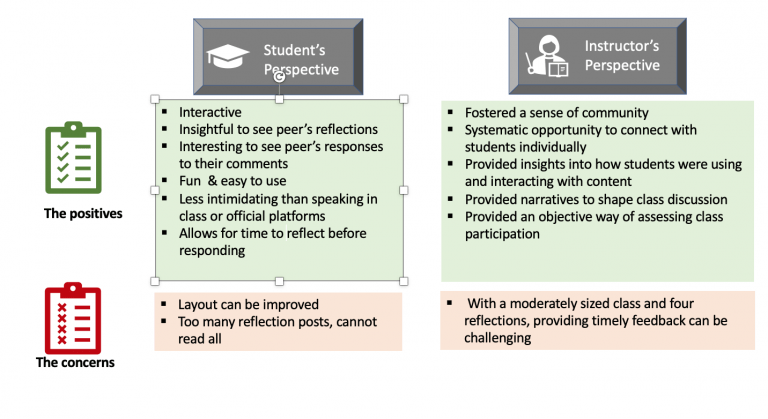Salome A. REBELLO
Saw Swee Hock School of Public Health (SSHSPH)
Salome shares her experience of using Padlet as a platform to foster online peer interaction among students taking her Public Health Nutrition module.

Rebello, S. A. (2021, Sept 27). Experiences with using Padlet to facilitate student interaction in an online setting. Teaching Connections. https://blog.nus.edu.sg/teachingconnections/2021/09/27/experiences-with-using-padlet-to-facilitate-student-interaction-in-an-online-setting/
The Challenge
When faced with the sudden transition from face-to-face to fully online teaching and learning in early 2020, students of my Level 2000 undergraduate module SPH2202104 “Public Health Nutrition” reported missing the opportunity to engage and interact with peers. Within the online learning space, we still had synchronous group-based tutorial sessions albeit via Zoom breakout rooms. Also, the quality of student’s work based on assessments was comparable to other years. However, I also observed that, compared to previous years, the level of vibrancy and camaraderie during these sessions was lower. Given our forced exile from face-to-face teaching, I asked myself if I could use this as an opportunity to address some of the challenges of class participation in traditional face-to-face settings, including social shyness, the fixed amount of time available for interaction during synchronous sessions and dominating voices of certain members (Hamann et al., 2012).
The Approach
For the cohort of Academic Year 2020/21, comprising 69 students, I experimented with providing more structured opportunities for student interaction by using Padlet as an asynchronous collaborative learning platform. The activities were informed by constructivism theory (Boghossian, 2006) which advocates for learning through scaffolding, reflection, and interaction.
The broad design of this activity is illustrated below:

Specifically, students were asked to write 300-word reflection pieces that allowed them to integrate personal experiences or apply class learning, which they subsequently posted on Padlet. Classmates could view and respond to their peers’ posts; meanwhile, I also provided individual feedback privately to each student. An example of a reflection activity in SPH2202 is where students had to interview a family member on the key barriers they faced to healthier eating, and to interpret this through the lens of the socio-ecological conceptual framework. The submitted posts, and comments of posts were not anonymised; instead, the “liking” of posts was disabled within the Padlet space to prevent social comparison and potential negative effects (Wallace & Buil, 2021).
There were four reflection activities in SPH2202, evenly spaced throughout the semester, each contributing 5% to the module’s overall grade. Posting comments on Padlet contributed to class participation, though other measures of class participation (for example, participation during Zoom sessions) were also considered.
The Observations
Most students posted at least one comment across the four reflection pieces submitted by their peers and on average posted about two comments per reflection activity. In an ancillary survey administered at the end of the semester, we asked students to share their experiences using Padlet. Students viewed the use of this platform positively, describing this as “easy to use”, “fun”, “fresh”, and “less intimidating” compared to official forums or speaking up in class (Figure 2). Most students valued the opportunity to view their peers’ reflections, which they typically are not be able to see, and to see how their peers responded to their reflections. The activity as a whole was described by students as being interactive and insightful. Some indicated that this form of interaction provided them with time to think and reflect further before responding. Although the feedback was overwhelmingly positive, some students felt that certain features of the platform, such as the layout, could be improved. Others also felt that the large number of reflections given the class size meant that they could not go through all of the reflections of their peers or post their own comment on these reflections.
As an instructor, I found many of the reflections thoughtful, and there were several thought-provoking submissions demonstrating high levels of critical reasoning. Students’ comments were always respectful, and many were informative and insightful. As I provided individual feedback privately to students about their submitted reflections, I found that this was also a good opportunity to connect with them individually throughout the semester. These reflection posts also served as a starting point for discussions during the lecture sessions on Zoom. Overall, there was a good sense of camaraderie and engagement during these sessions, which may be partly related to the spillover effects of student interactions on Padlet.

Conclusions
In a moderately-sized class of 69 students, using the Padlet platform provided an alternate pathway of expression and cognitive engagement, which seemed largely inclusive, providing opportunities in terms of time and space for all students to speak, thus partly addressing some of the barriers to participation during synchronous sessions. This platform serves to extend the value of reflection essays and may be a viable addendum to synchronous participation approaches.
 |
Salome A. REBELLO is a lecturer from the Saw Swee Hock School of Public Health. She currently teaches undergraduate and graduate modules focussing on nutrition and epidemiology. Salome is passionate about exploring ways to make learning authentic , empowering and engaging. Salome can be reached at ephsar@nus.edu.sg. |
References
Boghossian, P. (2006). Behaviorism, constructivism and Socratic pedagogy. Educational Philosophy and Theory, 38(6), 713-722. http://dx.DOI.org/10.1111/j.1469-5812.2006.00226.x
Hamann, K., Pollock, P. H., & Wilson, B. M. (2012). Assessing student perceptions of the benefits of discussions in small-group, large-class, and online learning contexts. College Teaching, 60(2), 65-75, http://dx.DOI.org/10.1080/87567555.2011.633407
Wallace, E., & Buil, I. (2021). Hiding Instagram likes: Effects on negative affect and loneliness. Personality and Individual Differences, 170. http://dx.doi.org/10.1016/j.paid.2020.110509

